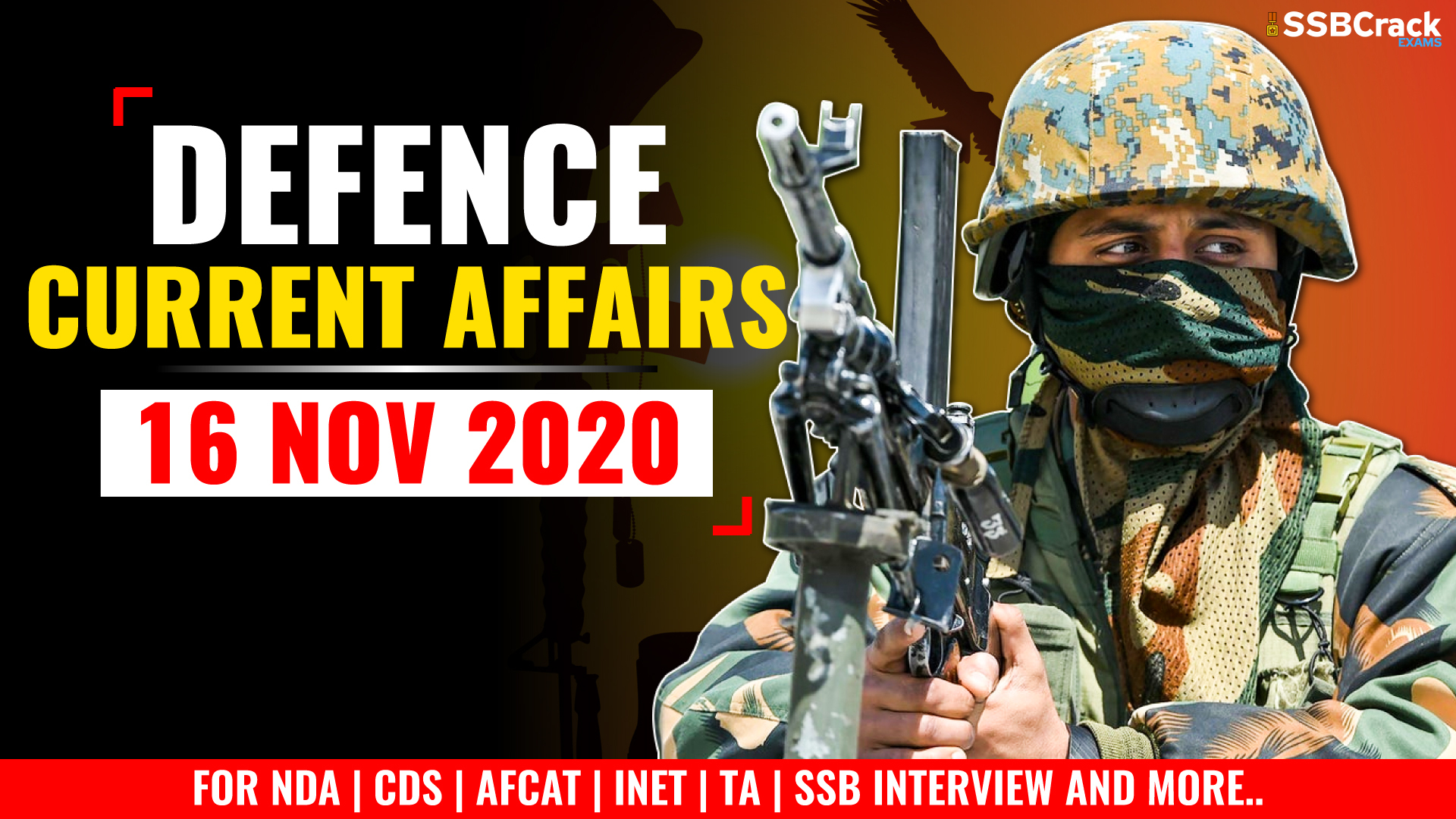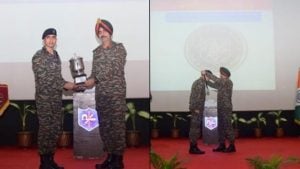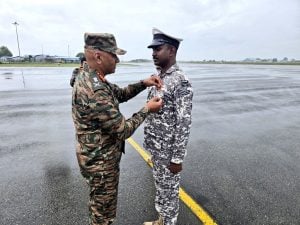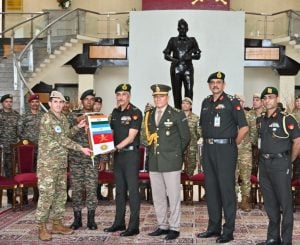QRSAM Missile System Achieves Major Milestone
- Quick Reaction Surface to Air Missile (QRSAM) System has achieved a major milestone by a direct hit on to a Banshee Pilotless target aircraft at medium range & medium altitude.
- The missile launch took place from ITR Chandipur on 13th Nov 2020 at 1550 hrs off the Odisha Coast. The missile is propelled by a single stage solid propellant rocket motor and uses all indigenous subsystems. The Missile is canisterised for transportation and launch using a mobile launcher capable of carrying 6 canisterised missiles.
- All QRSAM weapon system elements like Battery Multifunction Radar, Battery Surveillance Radar, Battery Command Post Vehicle and Mobile Launcher were deployed in the flight test. The system is capable of detecting and tracking targets on the move and engaging target with short halts. The system is designed to give air defence coverage against strike columns of Indian Army.
- The radar tracked the Banshee target from farthest range and missile was launched when target was within kill zone and achieved the direct hit with terminal active homing by RF Seeker guidance. Various DRDO labs DRDL, RCI, LRDE, R&DE(E), IRDE, ITR have participated in the test.
- The weapon system elements have been realized through Defence PSUs BEL, BDL and private industry L&T. The missile system is fully indigenous with active RF Seekers, Electro Mechanical Actuation (EMA) systems sourced from various industries. The Radar is four walled Active Phased Array Radar. All range Tracking stations, Radar, EOTs & Telemetry Stations monitored the flight parameters.
- Raksha Mantri Shri Rajnath Singh and Secretary DD R&D & Chairman DRDO Dr G Satheesh Reddy congratulated DRDO Scientists for the achievement.
CNS Visit to Campbell Bay
- The Chief of the Naval Staff Admiral Karambir Singh, PVSM, AVSM, ADC, visited INS Baaz, the Naval Air Station located at Campbell Bay, Great Nicobar Island on 13 November 2020. The visit was aimed to express solidarity with personnel on the occasion of Deepawali.
- The CNS was received by Lieutenant General Manoj Pande, AVSM, VSM, Commander-in-Chief Andaman & Nicobar Command (CINCAN). He was briefed on the operational preparedness and infrastructure aspects of the Command, including readiness in the prevalent security scenario.
- During his interaction with personnel at INS Baaz, the CNS acknowledged their contribution in keeping the strategically important base operational at all times. Personnel from Indian Army, Indian Air Force, Coast Guard, DSC and GREF, as well as Defence civilians were present during this occasion.
- The geo-strategically located Air Station, INS Baaz, overlooks critical International Sea Lanes passing through the IOR.
- The Airbase supports operations of a multitude of military aircraft, which enable surveillance over the Southern Bay of Bengal, South Andaman Sea, Malacca Straits and the Southern Indian Ocean.
- INS Baaz provides Aid to Civil Authorities, including Casualty Evacuation, Humanitarian Assistance and Disaster Relief and Search and Rescue and also serves as a supporting base for operational turn-around facilities of ships deployed in the Nicobar Group of Islands.
Russia deploys attack helicopters to Nagorno-Karabakh conflict zone
- The Nagorno-Karabakh conflict is an ethnic and territorial conflict between Armenia and Azerbaijan over the disputed region of Nagorno-Karabakh, inhabited mostly by ethnic Armenians, and seven surrounding districts, inhabited mostly by Azerbaijanis until their expulsion during the First Nagorno-Karabakh War, which are de facto controlled by the self-declared Republic of Artsakh, but are internationally recognized as de jure part of Azerbaijan. The conflict has its origins in the early 20th century, though the present conflict began in 1988, when the Karabakh Armenians demanded that Karabakh be transferred from Soviet Azerbaijan to Soviet Armenia. The conflict escalated into a full-scale war in the early 1990s.
- A ceasefire signed in 1994 provided for two decades of relative stability, which significantly deteriorated along with Azerbaijan’s increasing frustration with the status quo, at odds with Armenia’s efforts to cement it. A four-day escalation in April 2016 became the deadliest ceasefire violation until the 2020 conflict.
- Following the capture of Shusha, the second-largest settlement in Nagorno-Karabakh, a peace agreement was signed between the President of Azerbaijan, Ilham Aliyev, the Prime Minister of Armenia, Nikol Pashinyan, and the President of Russia, Vladimir Putin, ending all hostilities in the area from 00:00, 10 November 2020 Moscow Time.
- Dates of the war: 27 September 2020 – 10 November 2020 (1 month and 2 weeks)
- Location of war: Line of Contact, Nagorno-Karabakh, Armenian-controlled territories in Azerbaijan, Armenia-Azerbaijan border
- Result: Azerbaijani victory
- Ceasefire agreement signed on 10 November 2020.
- Azerbaijan retains control over the territories that it recaptured during the war.
- Russian peacekeeping forces to be deployed to the region.
- Armenia is granted access to Nagorno-Karabakh through Lachin corridor.
- Start of the 2020 Armenian protests.
- Memorandum of understanding signed on 11 November 2020, for the formation of the Joint Turkish–Russian Center.
- Territorial changes during the war:
- Azerbaijan gains control of 5 cities, 4 towns, 240 villages, and the entire Azerbaijan–Iran border
- Post-ceasefire:
- Some parts of Nagorno-Karabakh, along with all Armenian-controlled territories surrounding Nagorno-Karabakh to be ceded back to Azerbaijan by 1 December 2020.
- Azerbaijan is granted direct land access to its exclave of Nakhchivan via a corridor through Armenia.
U.S. Special Forces participates in Swedish-led exercise
- The U.S. Special Operations Command Europe has announced that the U.S. units conduct joint operations during a Swedish-led exercise along the Baltic Sea coast.
- Swedish JAS-39 fighter jets and U.S. CV-22B, F-15, and MC-130 aircraft flew over Gotland, during a joint exercise across the Baltic Sea, the Special Operations Command Europe has announced.
- “Swedish and U.S. forces conduct qualified exercises together with partners to strengthen defense capabilities across land, air, and sea domains to deter any opponent,” the news release says.
- The exercise involving U.S. units has been planned for a long time and is conducted in November, and it is a part of Swedish-U.S. bilateral cooperation.
- “Strong ties to the U.S. are vital to our and Europe’s security. Particularly concerning our military capability and technical supply. That is why we have close cooperation with the US, which this bilateral exercise demonstrates. The exercise reinforces our capability to conduct advanced air operations and efforts in Sweden and abroad”, says Colonel Malin Persson, Head of the Skaraborg Air Wing.
- U.S. personnel is staying and working at the Skaraborg Air Wing for the duration of the exercise. Host Nation Support means that the Swedish Armed Forces, as well as other public agencies, invites and enables foreign units to operate on Swedish territory, with logistical and practical support. The hosting unit must be thoroughly prepared.
U.S. Air Force implements dog-like robots into defense regiments
- According to a press release issued by 325th Fighter Wing, Tyndall Air Force Base and the Security Forces Squadron will be one of the first Air Force bases to implement semi-autonomous robot dogs.
- These computerized canines demonstrated their abilities Nov. 10 at an event attended by Maj. Gen. Tom Wilcox, Air Force Installation and Mission Support Center commander, and leadership from the 325th Fighter Wing and the Tyndall AFB Program Management Office.
- While these robots walk on all fours and resemble a dog, they are not intended to replace the military working dogs. Instead, they will aid in patrolling operations and, in doing so, allow Tyndall AFB’s defenders to focus their efforts on security actions that require a physical presence.
- “These robot dogs will be used as a force multiplier for enhanced situational awareness by patrolling areas that aren’t desirable for human beings and vehicles.” Criss said.
- Criss explained that the robot dogs will be given a patrol path which will be set and monitored by the Security Forces Electronic Security Sensor System non-commissioned officer in charge.
- “We will be able to drive them via a virtual-reality headset within our Base Defense Operations Center,” Criss said. “We will be able to see exactly what the robot dog is detecting through its mobile camera and sensor platform if desired, we will also be able to issue verbal commands to a person or people through a radio attached to the dogs.”
QUICK REVIEW
- Ceasefire agreement of Armenia and Azerbaijan was signed on
- 10 November 2020
- 11 November 2020
- 12 November 2020
- 13 November 2020
ANSWER: A
- The Naval Air Station located at Campbell Bay, Great Nicobar Island is
- INS Garuda
- INS Baaz
- INS Rajali
- INS Utkrosh
ANSWER: B
- QRSAM means
- Quick Reaction Surface to Air Missile
- Quick Reverse Surface to Air Module
- Quick Retrodiction Surface to Air Missile
- Quick Refraction Surface to Air Module
ANSWER: A
- Post Armenia – Azerbaijan war 2020, which country gained control of 5 cities, 4 towns, 240 villages, and the entire Azerbaijan–Iran border?
- Russia
- Armenia
- Azerbaijan
- Iran
ANSWER: C
- U.S. Air Force recently implemented which animal like robots into defense regiments, especially in the Tyndall Air Force Base?
- Mosquito-like
- Fish-like
- Dog-like
- Bat-like
ANSWER: C





















